 All Our Tours
All Our Tours
Written by: Vicky Nguyen
Updated date:02/08/2025
Hello, I’m Vicky! As a passionate travel enthusiast and tour planner at Asia Viva Travel, I’ve gathered extensive experience traveling across Vietnam and other captivating destinations in Southeast Asia. Now, I’m thrilled to share these adventures with you through my blog. From my journeys, I’ve gained a deep understanding of the unique cultures, hidden gems, and unforgettable experiences that this region has to offer. My goal is to bring you authentic and practical insights to help you design your own remarkable adventures. Join me, and let’s discover these extraordinary places together!
Contents
Step into the heart of Central Vietnam, where ancient towns whisper stories of the past, royal flavors linger on your palate, and every journey from Hue to Hoi An unveils something unforgettable. Whether you’re planning a Hue day trip from Danang, strolling through the lantern-lit streets of Hoi An, or discovering hidden gems beyond the usual Danang city tour, this region promises beauty, culture, and soul.
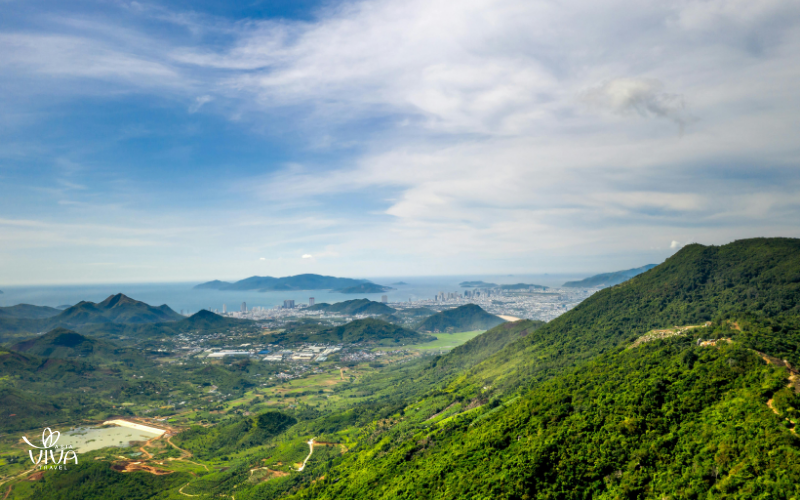
Where nature meets history_ Central Vietnam’s stunning coastlines and forested hills
Central Vietnam is where nature, heritage, and modern experiences converge in perfect harmony.This region boasts a rich geographic diversity – coastal plains, lush forests, mountain ranges, and endless beaches. Thanks to its central location and coastal influence, the region enjoys a mild and traveler-friendly climate, making it a year-round destination for U.S. visitors seeking both adventure and relaxation.
What truly sets Central Vietnam apart is its seamless blend of historical depth and contemporary development. From the imperial city of Hue and the ancient streets of Hoi An to the sacred ruins of My Son, travelers can immerse themselves in centuries-old cultural heritage infused with Cham, Lao, and Vietnamese traditions.
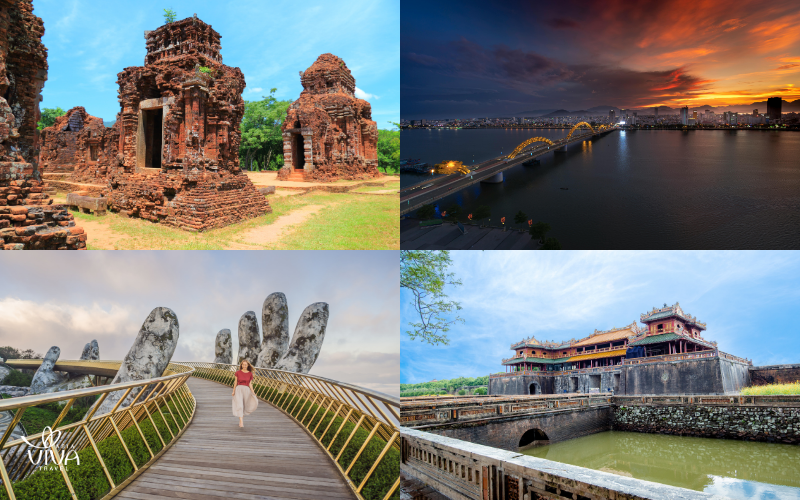
Timeless heritage_ Hue, Hoi An, and My Son preserve centuries of culture
Beyond the past, Central Vietnam is embracing the future. International-standard attractions like Ba Na Hills, the iconic Golden Bridge, and world-class theme parks are redefining the travel experience while preserving local charm. Meanwhile, the local cuisine – especially fresh seafood prepared with bold, coastal flavors, offers a delicious journey in every bite.
The future meets the clouds_ The iconic Golden Bridge at Ba Na Hills
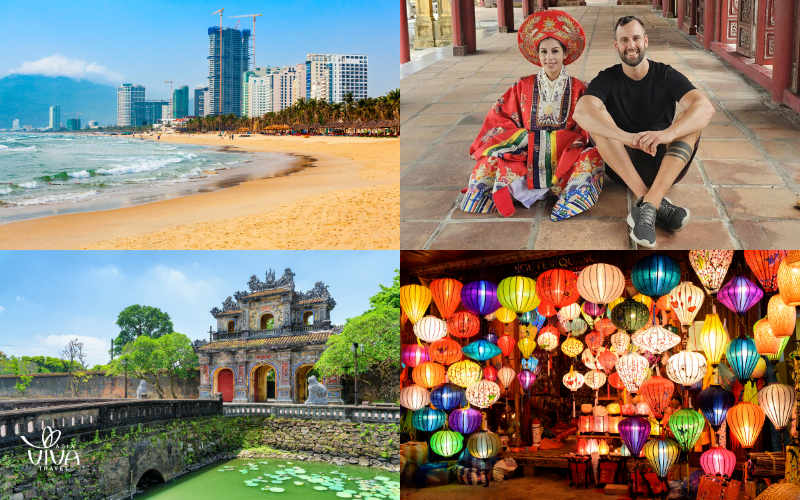
Hue, Hoi An, Da Nang — each city tells a story of Central Vietnam’s soul
f
For travelers looking to uncover the soul of Central Vietnam, three cities stand out as essential chapters in the story: Hue, Hoi An, and Da Nang. Each offers a unique experience together, they paint a complete picture of the region’s history, tranquility, and modern vitality.
Hue is Vietnam’s ancient royal capital, where echoes of the Nguyen Dynasty still linger in imperial citadels, majestic mausoleums, and traditional court music. This city is a living museum of feudal elegance and spiritual depth. Recognized by UNESCO as a World Heritage Site, Hue continues to charm history lovers and cultural explorers alike.
Hoi An is a poetic escape from the modern rush. This UNESCO-listed ancient town invites you to slow down, wander cobbled streets bathed in golden hues, and watch thousands of lanterns light up the night sky. With its unique blend of Vietnamese, Chinese, and Japanese influences, Hoi An has been named one of Asia’s Best Cities by Travel + Leisure and regularly ranks among the most charming towns in the world.
Da Nang stands as a symbol of contemporary Vietnam – dynamic, youthful, and constantly evolving. Known for its pristine beaches and bold urban planning, Da Nang was named one of the Top 10 Most Livable Cities in the World by Live and Invest Overseas. The city offers everything from adrenaline-pumping theme parks to iconic landmarks like the Golden Bridge held by giant stone hands. It’s where beach vibes meet modern ambition.
Each season in Central Vietnam unveils a unique charm. From vibrant seasonal festivals to ever-changing landscapes and authentic cultural encounters, travelers are guaranteed new and unforgettable experiences – even on return visits. This makes Hội An, Huế, and Đà Nẵng ideal destinations to explore year-round, without having to worry too much about timing.
That said, according to travel experts at Asia Viva Travel, the most ideal time to visit these three iconic cities is between February and April. This transitional period between spring and summer brings mild temperatures, gentle sunshine, and low humidity – perfect conditions for outdoor sightseeing, exploration, and cultural immersion.
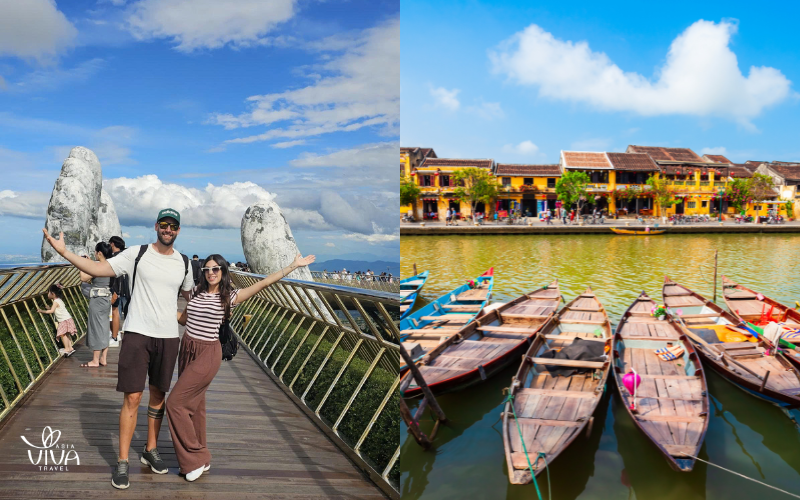
Spring serenity_ Central Vietnam is most welcoming from February to April
Due to its coastal geography, Central Vietnam is occasionally affected by typhoons, typically occurring from July to September, depending on the year. While it’s still possible to travel during this time, visitors are advised to avoid outdoor activities and instead focus on more relaxed or indoor experiences. With a deep understanding of local weather patterns, Asia Viva Travel offers expert advice and flexible itinerary planning to ensure your journey remains safe, smooth, and fulfilling – no matter when you choose to travel.
Though located close to one another, Hue, Da Nang, and Hoi An each offer a unique microclimate, adding an extra layer of character to your journey through Central Vietnam.
Hue tends to be the hottest of the three, especially during the summer months. The ancient capital, nestled inland and surrounded by mountains, often experiences prolonged heat and humidity. The air can feel dense, and the stillness of the city’s atmosphere during midday is almost poetic – intense, historic, and a bit dramatic, much like its imperial legacy.
Da Nang, while also hot during peak summer, is relieved by ocean breezes thanks to its prime coastal position. The city enjoys a more refreshing climate, especially in the late afternoon and evening when the sea wind sweeps in, making it more pleasant for beach walks or riverside dining.
Hoi An shares similarities with Da Nang in terms of weather, but its charming old town layout and slower pace make the heat feel more gentle, more ambient. Shaded alleyways, riverside cafés, and lantern-lit streets help soften the warmth, creating a tranquil and comfortable setting even on warmer days.
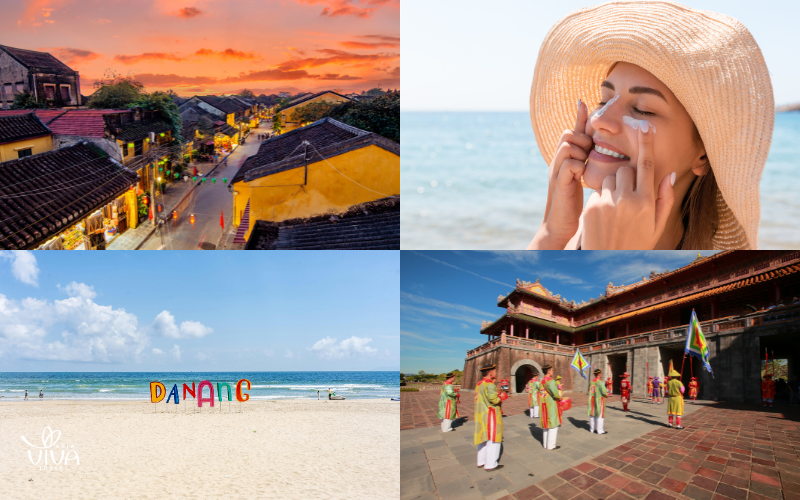
Each city’s rhythm, shaped by its climate and character
Vicky’s Travel Tip: To make the most of your visit in Central Vietnam’s warm climate, try exploring between 7:00 AM and 11:00 AM, when the air is still cool and the light is perfect for photos. After that, take a well-deserved break in a shady, air-conditioned restaurant for lunch. You can continue sightseeing around 3:00 PM, once the heat begins to ease. Don’t forget to pack sunscreen, sunglasses, and a small personal water bottle – staying hydrated and protected is key when moving around under the sun
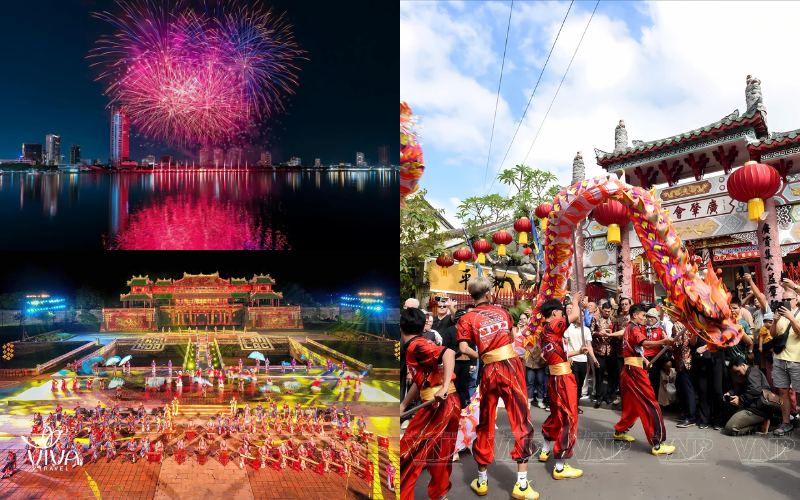
Festivals in Central Vietnam_ A symphony of light, music, and history
In Vietnamese tradition, festivals are more than celebrations, they are a way to enrich the spirit and preserve the cultural fabric of each region.
Compared to the North, where festivals often center around temples and rural traditions, and the South, where celebrations are more dynamic and spontaneous, Central Vietnam offers a balance of elegance, ritual, and symbolism. The festivals here are more structured and refined, yet infused with emotional depth and artistic expression – a perfect embodiment of the region’s poetic soul.
The Lunar New Year (Tết) is one of the most significant festivals in Vietnam – typically takes place between late January and February, depending on the lunar calendar. In Central Vietnam, Tết is infused with the region’s own unique customs:
Beyond Tết, Central Vietnam bursts with unique and dynamic festivals that showcase each city’s cultural identity:
Da Nang – The City of Lights and Fireworks
Each summer, Da Nang becomes a global stage for the Da Nang International Fireworks Festival (DIFF). Teams from around the world compete in a dazzling showcase of light, sound, and creativity, all themed around global unity and cultural pride. Set against the backdrop of the Han River, this event draws thousands of international visitors and turns the city into a festive, electric atmosphere unlike anywhere else in Vietnam.
Hoi An – A Lantern-Lit Reverie
As the “City of Lanterns,” Hội An hosts its Lantern Festival on the 14th day of every lunar month, when the full moon shines brightest. On these magical nights, all electric lights in the Old Town are switched off, letting thousands of colorful lanterns illuminate the streets, floating along the river and glowing in every doorway. In addition, the city celebrates the Annual Lantern Festival during Tết or Mid-Autumn, with parades, music, traditional games, and cultural performances – a dreamscape for photographers and romantics alike.
Hue – Imperial Grace Meets Cultural Revival
As the former imperial capital, Huế is home to deeply spiritual and historically rich festivals. The most iconic is the Huế Festival, held every two years (or annually depending on local initiatives), celebrating the city’s imperial heritage, performing arts, and cultural evolution. The festival features royal court music, traditional games, áo dài shows, culinary fairs, and international cultural exchanges, positioning Huế as a beacon of both Vietnamese tradition and modern vibrancy.
Among the three iconic cities of Central Vietnam including Da Nang, Hoi An, and Hue, there are 2 international airports: Da Nang International Airport (DAD) and Phu Bai International Airport (HUI) in Hue. As Hoi An does not have its own airport, the most convenient and efficient gateway for visiting all three destinations is through Da Nang.
Thanks to its strategic location, well-developed infrastructure, and frequent domestic and international flights, Da Nang has become the region’s most active air hub. With just a 10 ––15 minutes’ drive from the airport to the city center, travellers can begin their journey in Central Vietnam smoothly and without hassle.
From Da Nang, both Hoi An and Hue are easily accessible by road or rail:
Da Nang – Hoi An
To reach Hoi An, visitors travel a short distance of approximately 30 kilometers, which takes around 40 to 45 minutes by private car, taxi, shuttle, or motorbike. The route itself is a gentle, scenic ride, offering glimpses of tranquil villages and riverside life before arriving in the charming ancient town.
Da Nang – Hue
Heading north from Da Nang to Hue, the journey covers about 100 kilometers and can be completed by car or train. By car, it typically takes 2.5 to 3 hours, depending on whether one chooses the modern Hai Van Tunnel or the more scenic Hai Van Pass, which offers sweeping coastal views. Alternatively, traveling by train takes around 3.5 hours. Passengers can choose between regular SE trains, part of the Reunification Express line, which offer both seating and sleeper compartments, or opt for the Heritage Train—a curated tourism experience launched by Vietnam Railways to celebrate the route’s cultural richness.
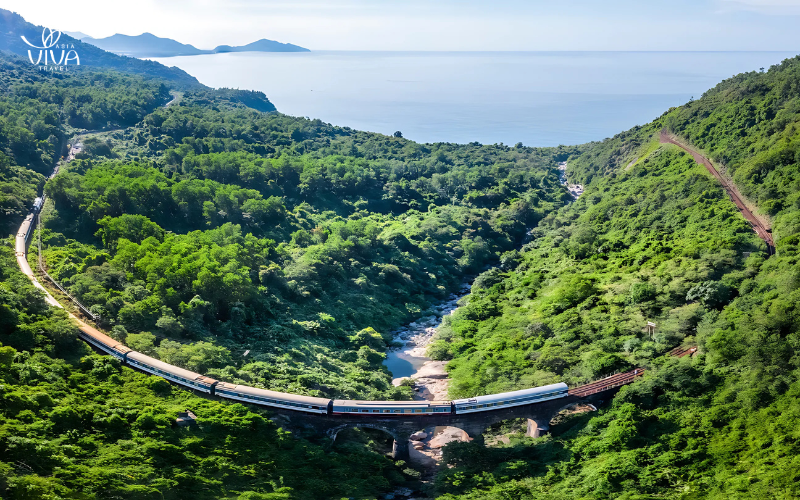
Ride the rails through Vietnam’s most breathtaking coastal landscape
Scenic Rail Journey
For those traveling from Da Nang to Hue, the train journey offers more than just a means of transport — it’s a visual feast. Regardless of the train type, the route exclusively follows the Da Nang–Hue railway line, winding its way through the legendary Hai Van Pass. This scenic coastal stretch has earned global praise from outlets like The Telegraph and CNN Travel, celebrated as one of the world’s most breathtaking train journeys. As the train glides along mist-veiled cliffs, hugs dramatic mountain curves, and offers sweeping views of the turquoise sea, passengers are treated to an unforgettable glimpse of Central Vietnam’s natural splendor — a highlight unique to this route between Da Nang and Hue.
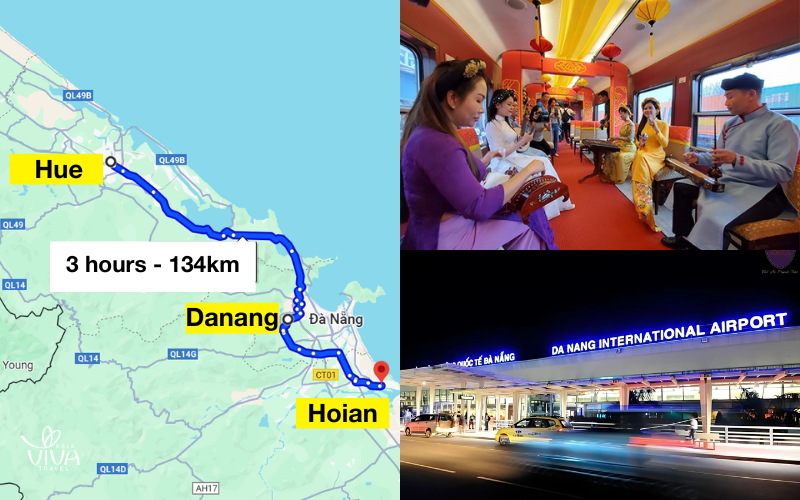
Smooth connections: Getting around Central Vietnam is simple and scenic
For wonderful experiences in Danang- Hoian-Hue, Asia Viva Travel recommend you amazing itinerary for travellers:
Day 1: Arrival in Da Nang – Transfer to Hoi An
Upon arrival at Da Nang International Airport, travellers will be transferred directly to a hotel in Hoi An.
Optional activities in Da Nang before transfer: strolling along the Han River, visiting Dragon Bridge, relaxing at My Khe Beach, experiencing a seafood food tour, exploring Asian Park, or visiting Linh Ung Pagoda. For those with more time, an extra day can be added to visit Ba Na Hills.
Overnight in Hoi An
Day 2: Cam Thanh Village – Hoi An Ancient Town Tour
In the morning, explore the fishing village of Cam Thanh: cruise the Cua Dai River, meet local fishermen, and try navigating a basket boat through a coconut forest. Enjoy a traditional fisherman’s lunch.
In the afternoon, take a guided walking tour of Hoi An Ancient Town (UNESCO World Heritage Site), visiting Chua Ong Pagoda, Tan Ky Ancient House, and the Japanese Covered Bridge.
Overnight in Hoi An
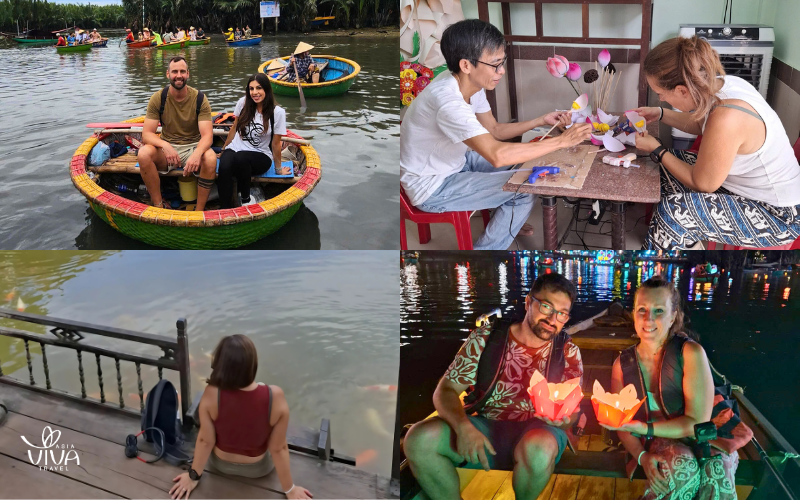
Unforgettable days in Central Vietnam, curated by Asia Viva Travel.
Day 3: Hoi An – Da Nang – Hue via Hai Van Pass
Free morning to relax on the beach or explore Hoi An independently.
In the afternoon, drive to Hue with scenic stops at the Marble Mountains and Cham Museum in Da Nang. Continue along the Hai Van Pass, one of Vietnam’s most spectacular coastal roads.
Overnight in Hue
Day 4: Hue Imperial City Tour – Chuon Lagoon Sunset Experience
Visit Hue Imperial Citadel Complex, including the Meridian Gate, Palace of Supreme Harmony, Royal Theatre, and The Mieu Temple. Continue to Tu Duc Tomb, an architectural masterpiece harmonizing with its natural surroundings.
In the late afternoon, transfer to Chuon Lagoon via Duong No village — the childhood home of Ho Chi Minh. Enjoy a sunset boat ride on the lagoon and an optional fresh seafood dinner at a floating restaurant.
Overnight in Hue.
HUE – The Imperial Kitchen of Vietnam
Elegant, refined, and deeply ceremonial – Hue’s cuisine reflects its royal legacy, where even everyday dishes once had to please the palate of kings so tourists can’t miss a chance to eat delicate dishes.
Bún bò Huế ( Beef noodle soup with toppings): A spicy, aromatic beef noodle soup with lemongrass, fermented shrimp paste, and chili oil. Traditionally served with slices of beef shank, crab balls, and pork hock. Locals pair it with fresh herbs and lime.
Bánh bèo ( Beo cake- steamed rice cake with shrimp floss): Small steamed rice cakes topped with minced shrimp, crispy pork skin, and scallion oil. Served in tiny dishes, eaten with a spoon and sweet-savory fish sauce. A classic royal snack.
Nem lụi ( Grilled lemongrass pork): Grilled lemongrass pork skewers, typically wrapped in rice paper with herbs, pickles, and dipped in rich peanut sauce. Reflects Central Vietnam’s love for layered textures and strong dipping sauces.
Chè Huế ( Hue sweet bean soup): Hue is the “dessert capital” of Vietnam, this sweet soup comes in many versions (mung bean, lotus seed, purple yam, corn). Often eaten cold as an afternoon treat.
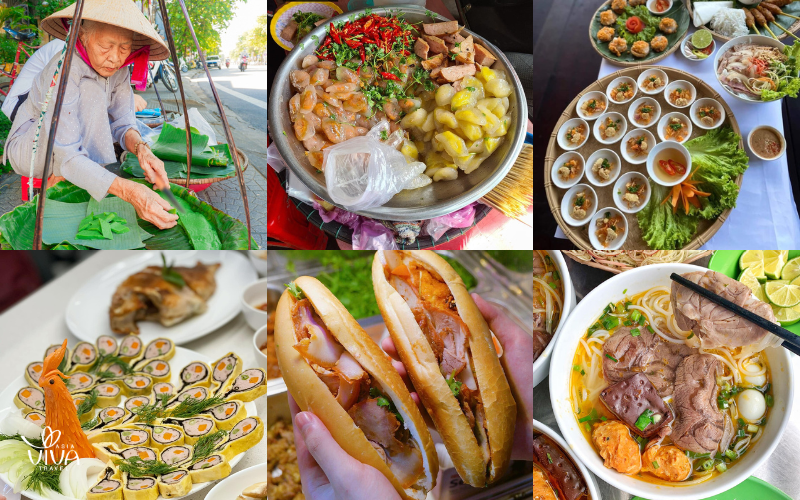
Hue’s royal kitchen: A taste of Vietnam’s culinary nobility.
DA NANG – Fresh from the sea, bold in flavor
Da Nang’s cuisine leans into the coastline’s bounty and spicy central-style seasonings. Seafood is king, and locals enjoy dishes with chili, garlic, and fermented sauces for that intense, satisfying flavor.
Mì Quảng ( Noodles with Seafood and Crispy rice crackers): A dry-style noodle dish topped with shrimp, pork, herbs, and rice crackers, served with a spoonful of rich broth. The turmeric-yellow noodles and crushed peanuts make it unmistakably local.
Bánh tráng cuốn thịt heo ( Rice paper roll with pork): Pork belly slices wrapped with herbs and fresh vegetables in rice paper, dipped in fermented anchovy sauce (mắm nêm). Clean yet punchy in flavor.
Hải sản nướng( Grilled seafood): Grilled seafood (scallops, clams, octopus) cooked over charcoal and brushed with green chili salt. Street vendors serve them fresh and sizzling.
Bún chả cá ( Noodle soup with fish cake): Noodle soup with grilled fish cakes, pineapple-tomato broth, and dill – bright, sweet, and satisfying.
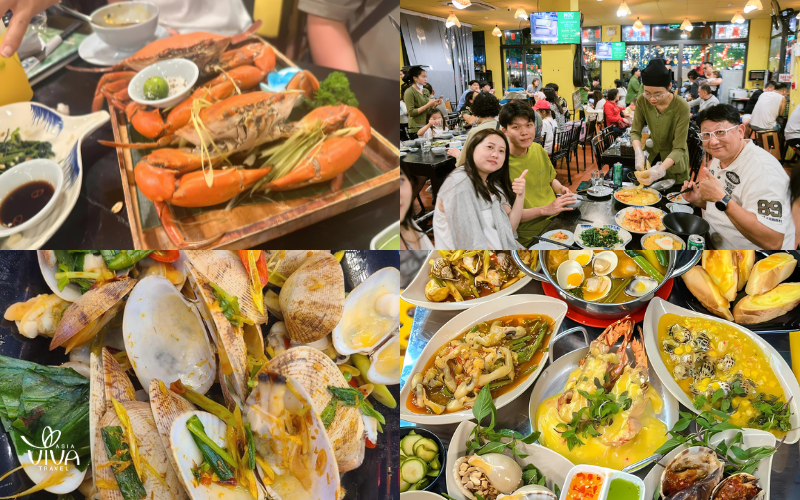
Spicy, bold, and fresh_ Da Nang’s seaside culinary treasures
HOI AN – Warming street food served with care
Hoi An’s culinary scene mirrors its ancient charm, it’s simple, heartwarming, and rooted in community. Street vendors, often women, serve steaming dishes with motherly hospitality and ingredients grown nearby.
Cao lầu ( Noodles mixed with Grilled pork): Thick rice noodles, sliced pork, herbs, and crispy rice crackers. The noodles are made with water from a specific ancient well, giving it a chewy texture.
Bánh mì Phượng ( Hoi An’s signature bread): Possibly Vietnam’s most famous sandwich. Crisp baguette filled with pork, pate, herbs, pickled carrots, and chili sauce – a mix of French and Vietnamese traditions.
Bánh bao – Bánh vạc ( Dumplings – Rose -shaped steamed rice cake): White rose dumplings filled with shrimp, delicately folded and steamed. Often served at family-owned restaurants, highlighting the town’s Chinese influence.
Cơm gà Hội An ( Chicken rice Hoi An’s style): Fragrant rice cooked in chicken broth, topped with shredded chicken, herbs, and papaya salad. A humble, comforting dish found across town.

Spicy, bold, and fresh_ Da Nang’s seaside culinary treasures
Note for Visitors
Many dishes have vegetarian versions; Spiciness, sweetness, or fish sauce intensity can usually be adjusted – don’t hesitate to let your restaurant know your preferences when ordering.
And if using chopsticks is a challenge, no worries – most restaurants are happy to offer forks or spoons to make your experience seamless.
From the imperial charm of Hue, to the nostalgic lantern glow of Hoi An, and the vibrant coastal spirit of Danang – Central Vietnam offers a journey through time, taste, and tradition. Whether it’s savoring royal cuisine, exploring ancient streets, or soaking in sea breeze and mountain air, each destination speaks to the soul in its own way.
Let these three cities quietly convince you why these deserve the title of Vietnam’s most livable places – not just to visit, but to remember.
Travel with Asia Viva Travel – where every journey is tailored with care, and every destination feels like home

 26/11/2025
26/11/2025A travel guide with tips for first time travellers to Vietnam covers everything from getting a visa, Internet, SIM Cards, tipping and how to get around, survival tips and more

 26/11/2025
26/11/2025Visiting Cambodia and Vietnam for stunning landscapes, vibrant cities, ancient temples, and UNESCO World Heritage sites is a complete travel experience for tourists.

 26/11/2025
26/11/2025Visit Da Nang with our detailed guide to the best hotels, resorts, Michelin-starred restaurants, and local street food for an unforgettable Vietnamese getaway.

 26/11/2025
26/11/2025Discover the best Vietnam tour packages from USA and enjoy a safe, unforgettable journey through Vietnam’s culture, beautiful nature, and rich history.